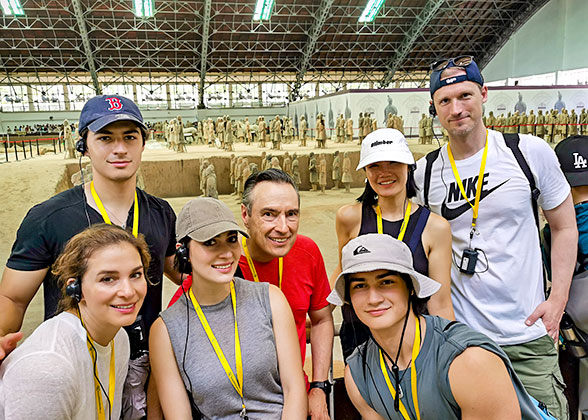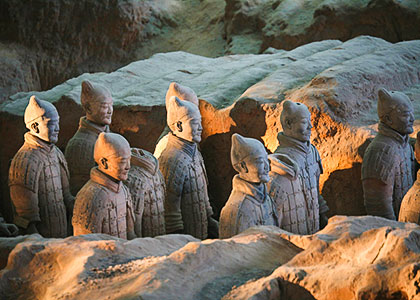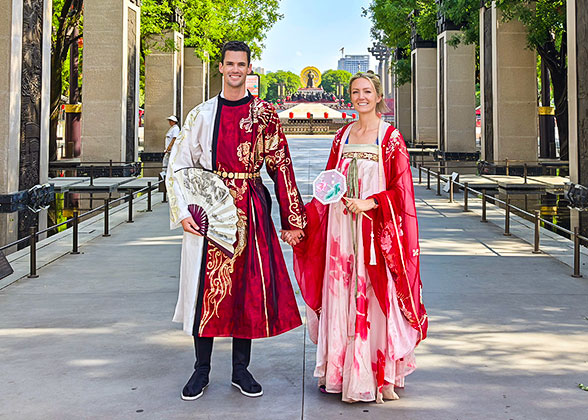Half Day Private Xi’an City Wall Walking Tour
Xiaonanmen Morning Market - City Wall Remains Museum - City Wall - West Garden of City Wall Park - Guangren Temple
From USD49 per person Book
- Itinerary
- Prices
- Reviews
Trip Highlights
- Ascend ancient Xi’an City Wall to explore its defense designs and overlook urban landscape.
- Taste genuine local life at a morning market and the City Wall Park.
- Make a pilgrimage to 300-plus-year-old Guangren Temple featuring Tibetan Buddhism.
- No commission-based shopping stops! More time will be spent on attractions and you will enjoy a pure sightseeing tour.
- No optional tours! Optional tour is just a tourist trap and will always cost you more with a high markup on price.
This trip can be customized to meet your individual needs!
● Walking Distance: about 5 kilometers (3 miles)
● Duration: 4 to 5 hours
● Difficulty: easy pace, suitable for all fitness levels, with just a few stairs
● What to Prepare: comfortable walking shoes, sunscreen
Welcome to spend a morning with us on a fantastic Xi’an city walk around its ancient City Wall, a widely admired landmark for both visitors and locals. We’ll start with a morning market, so an early departure is recommended to catch its liveliest moments with best experience. At the agreed-upon time, your private guide will meet you at your downtown hotel and accompany you by metro or public bus to the South Gate of the City Wall. After admiring the magnificent gate tower, let’s walk 15 minutes along the foot of the City Wall to the Morning Market at the Small South Gate, a perfect venue to immerse yourself in the authentic local life. Here, the loud shouts of vendors and the haggling dialects of the elderly interweave, jointly composing a melodious symphony of urban hustle and bustle. Prepare to be overwhelmed by the aromas of various specialty snacks, such as Chinese Hamburgers, Glutinous Rice with Jujube, and Vegetable Stew with Meatballs, from more than a hundred stands. Also, feast your eyes on a dazzling array of sugar paintings, exquisite embroideries, and hand-woven bamboo baskets created by local artisans.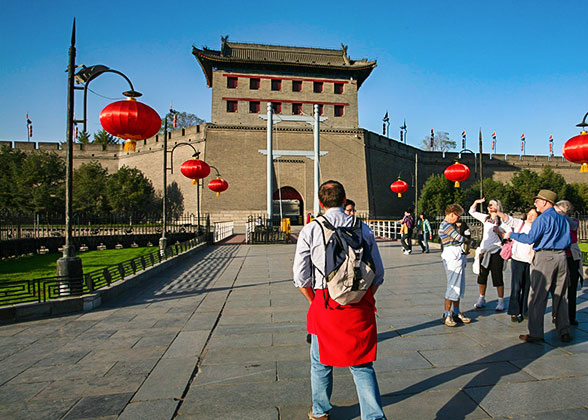
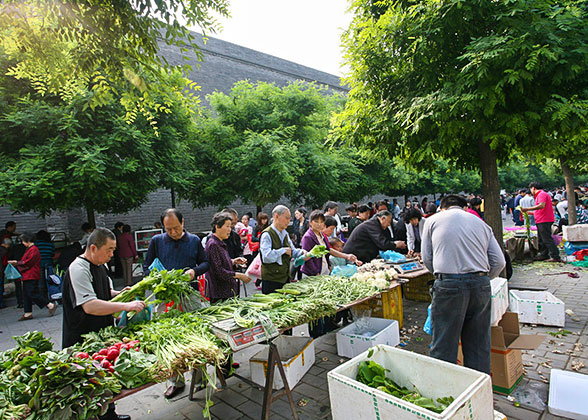 Continue to the west, and we’ll reach the City Wall Remains Museum, aka Hanguang Gate Site Museum. As you step in, learn about the architectural style and historical features of the City Wall over 1,400 years ago from the elaborate restoration model of the Hanguang Gate and the layout diagram of the old imperial city. Then walk further inside to marvel at the ruins of the cross-section of the wall, the water culverts, and the gate with three large doorways, all of which demonstrate the wisdom of ancient Chinese craftsmen.
Continue to the west, and we’ll reach the City Wall Remains Museum, aka Hanguang Gate Site Museum. As you step in, learn about the architectural style and historical features of the City Wall over 1,400 years ago from the elaborate restoration model of the Hanguang Gate and the layout diagram of the old imperial city. Then walk further inside to marvel at the ruins of the cross-section of the wall, the water culverts, and the gate with three large doorways, all of which demonstrate the wisdom of ancient Chinese craftsmen.
After that, officially climb onto the Xi’an City Wall. Spanning 14 kilometers (8.5 miles), it’s the oldest and best-preserved city wall in China, a silent guardian of a former capital that once housed thirteen dynasties. Originally built in the 6th century to defend the imperial city and underwent continuous expansion and repair until 600 years ago, it finally became what you see today. Take your time to stroll along the wide walkway and observe up close various battlements with numerous crenels on both sides, grand gate towers, as well as the ‘horse faces’, which are platforms with corner towers or watchtowers extending from the wall. The intervals between these extensions are equidistant, which is determined not by chance but by the effective range of the ancient bows and crossbows. From atop the wall, you can look inward to admire the archaistic or ancient structures including the iconic Bell Tower in the city center, and outward to find a forest of modern high-rises, a striking contrast between past and present.
► Glimpse into Names of Gates of City Wall
It is fascinating to know that the names of all its 18 gates are related to some famous figures or major events in Chinese history. In particular, there are more profound meanings behind the four main gates. The South Gate, known as Yongning (eternal peace) Gate, is a prayer to the God of Fire located in the south in traditional Chinese culture for no fire disasters and peace forever. The West Gate (Anding Gate) carries the ancient emperors’ wishes for stability on China’s western frontier, while the North Gate (Anyuan Gate) similarly reflects the hope for pacifying the northern nomadic tribes. The East Gate, Changle Gate, symbolizes the eternal joy of the people of the country.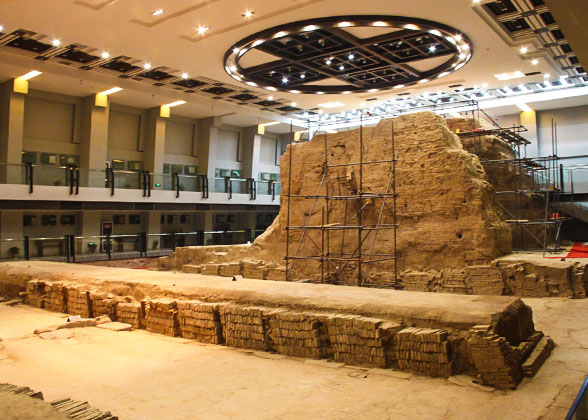
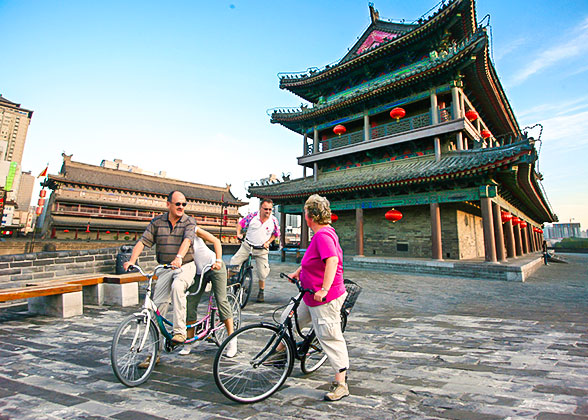 ► Friendly Tips:
► Friendly Tips:
1. Walking the entire perimeter of the City Wall would take approximately 4 hours, and there’s no need to complete such a lengthy trek. We generally recommend a walk from Hanguang Gate to West Gate, which takes about one hour, passing several iconic gate towers and the unique circular southwestern corner. Should you feel tired at any point, your guide can lead you down from the nearest exit.
2. If you’re interested in covering more ground, single and tandem bicycle rentals are available on the wall, and your guide can assist you with the rental process at your own expense. Please be aware that cycling the entire perimeter, even with short breaks for drinking water or photos, can take around 2 hours. Given the uneven path atop the wall and potential for hot weather, you might find it more enjoyable to cycle just a short section if you’re interested.
Coming down from the City Wall, let’s go on a leisurely stroll in the West Garden, the best section extending from the southwest corner to the northwest corner of the City Wall Park, a recreational green belt on the outside fringe of the Wall. Looking at the willows swaying gently in the breeze along the wide lawns and the sunlight shining on the serene emerald moat with flocks of ducks swimming in, you may feel as if you were in a refreshing scene from the works of Hayao Miyazaki, a famous Japanese cartoonist. What will also catch your attention are the locals doing exercises on fitness facilities under lush trees, walking their pet birds, playing table tennis, singing Shaanxi Opera, or just basking in the sun. This is where you can experience a kind of slow-paced life in Xi’an.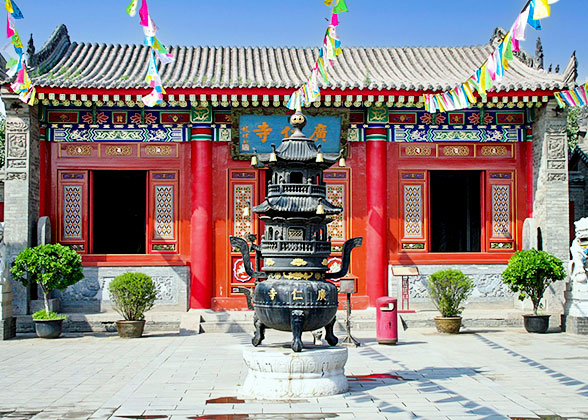
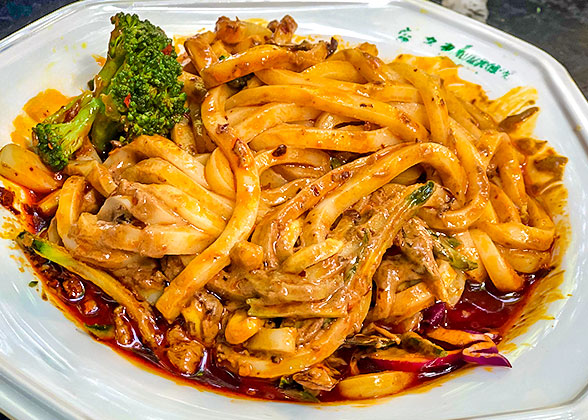 Finally, make our way to the Guangren Temple, hidden within the northwest corner of the City Wall. Built more than 300 years ago, it is the only Tibetan Buddhist monastery in Xian. In front of the gate, there are eight imposing white pagodas that celebrate the merits of Sakyamuni, high prayer flags, and hanging hadas, the long pieces of silk used as the greeting gift, allowing you to feel the strong Tibetan cultural atmosphere. After entering, apart from glided Buddha statues like Shaanxi’s largest Thousand-Hand Avalokitesvara in Devajara Hall and three Bodhisattva statues in Mahavira Hall, you’ll be amazed by the Ten Thousand Year Lamp, which can be filled with 54 kilograms of kerosene at a time to keep it lit day and night. When enjoying the cool under the centuries-old cypress trees, your guide will also give you wonderful commentaries about them.
Finally, make our way to the Guangren Temple, hidden within the northwest corner of the City Wall. Built more than 300 years ago, it is the only Tibetan Buddhist monastery in Xian. In front of the gate, there are eight imposing white pagodas that celebrate the merits of Sakyamuni, high prayer flags, and hanging hadas, the long pieces of silk used as the greeting gift, allowing you to feel the strong Tibetan cultural atmosphere. After entering, apart from glided Buddha statues like Shaanxi’s largest Thousand-Hand Avalokitesvara in Devajara Hall and three Bodhisattva statues in Mahavira Hall, you’ll be amazed by the Ten Thousand Year Lamp, which can be filled with 54 kilograms of kerosene at a time to keep it lit day and night. When enjoying the cool under the centuries-old cypress trees, your guide will also give you wonderful commentaries about them.
So far, your half-day Xi’an City Wall tour itinerary has come to an end, and you’ll be escorted back to your hotel by public transport.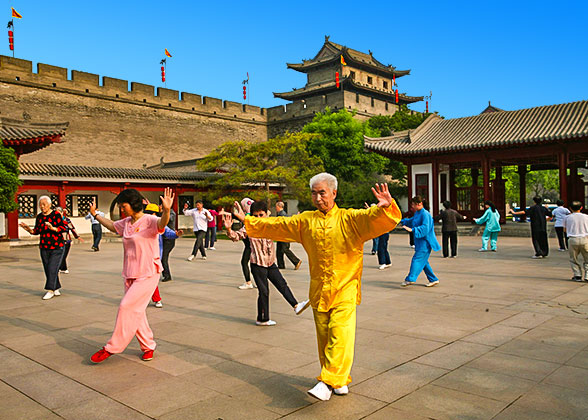
 ● Unlock Other Popular Ways to Explore the City Wall (for your reference):
● Unlock Other Popular Ways to Explore the City Wall (for your reference):
1. Immerse Yourself in Local Life: Beyond the above Morning Market and West Garden, consider exploring the East Shuncheng Lane Morning Market near the East Gate for an even more authentic local vibe. For genuine local interactions, head to the South Garden of the City Wall Park.
2. Discover History and Culture: Visit the Stele Forest Museum near Wenchang Gate for stele carving art collections and the former site of Xi’an’s Confucius Temple, and drop by the nearby Shuyuanmen Street buzzing with cultural relic stores and Chinese calligraphy studios.
3. Capture Memories in Traditional Costume: Rent a set of traditional Chinese Hanfu clothing from studios around the Drum Tower area. Put on featuring makeup to take incredibly Instagrammable photos against the backdrop of the City Wall.
4. Indulge in Local Cuisine: While the well-known Muslim Quarter in the city center offers delicious halal food and barbeque, don’t miss Yongxingfang Food Street near the east Zhongshan Gate for more authentic local snacks, such as Biang Biang Noodles, Qishan Noodle Soup with Diced Meat, Zichang Pancake, and Zhashui Potato Cake. For an evening drink, explore the diverse exotic bars and cafes lining the South Shuncheng Lane beneath the City Wall.
5. Experience Nightlife and Performances: The South Gate is the hub for performances. During the day, you can see the grand welcome ceremony in the city gate enclosure. At night, the gate tower is illuminated by dazzling lights, with the spectacle reaching its peak during the Lunar New Year’s annual lantern fair. On ordinary evenings, consider the paid performance of ‘Chang’an Impression’ (1 hour, at 20:00 or 20:30 from April to October). This large-scale outdoor show features actors in ancient outfits performing against the City Wall, accompanied by infectious music and stunning light effects. For free entertainment, the lively atmosphere of the local folk bands in the doorway of the South Gate will not disappoint you.
► If you are interested in any of the above attractions or activities around the City Wall, just contact us to extend your itinerary or help you book the tickets. For more well-known sites in and around Xi’an, such as the Terracotta Army, Giant Wild Goose Pagoda, or Mt. Huashan, feel free to let our travel experts tailor a trip for you.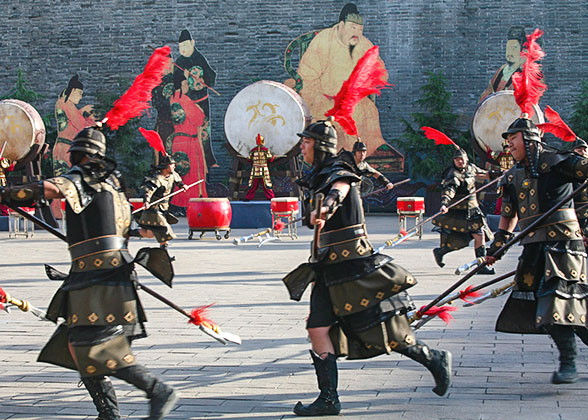
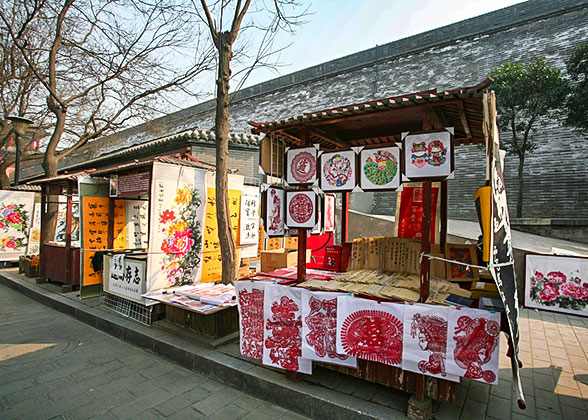 ● Prefer to travel to the City Wall by yourself? The following information is for your reference:
● Prefer to travel to the City Wall by yourself? The following information is for your reference:
• Entrance Fee: CNY 54
The ticket can be bought through the Xi’an City Wall WeChat mini-program. If it’s not convenient for you, get it on the spot at one of the gates.
• Opening Hours
South Gate: 8:00 - 22:00; West/East/North Gate: 8:00 to 20:00.
• How to reach the South Gate (Yongning Gate)?
1. By subway: Take Subway Line 2 and get off at Yongningmen station. Leave from Exit D2 and walk 2 minutes north, and then turn left and find the ticket office in 50 meters (160 feet).
2. By bus: Find the most convenient bus nos. 12, 193, or 600, etc. to Nanmenli, or nos. 6, 40, 208, or 800 to Nanmenwai.
3. If you start from the Xi’an Xianyang International Airport, take the Airport Shuttle Bus - Bell Tower Route at Terminal 2, get off at Bell Tower Hotel Xi’an, and then walk 20 minutes southward to reach the South Gate. The whole trip takes about 2 hours.
● Duration: 4 to 5 hours
● Difficulty: easy pace, suitable for all fitness levels, with just a few stairs
● What to Prepare: comfortable walking shoes, sunscreen
Welcome to spend a morning with us on a fantastic Xi’an city walk around its ancient City Wall, a widely admired landmark for both visitors and locals. We’ll start with a morning market, so an early departure is recommended to catch its liveliest moments with best experience. At the agreed-upon time, your private guide will meet you at your downtown hotel and accompany you by metro or public bus to the South Gate of the City Wall. After admiring the magnificent gate tower, let’s walk 15 minutes along the foot of the City Wall to the Morning Market at the Small South Gate, a perfect venue to immerse yourself in the authentic local life. Here, the loud shouts of vendors and the haggling dialects of the elderly interweave, jointly composing a melodious symphony of urban hustle and bustle. Prepare to be overwhelmed by the aromas of various specialty snacks, such as Chinese Hamburgers, Glutinous Rice with Jujube, and Vegetable Stew with Meatballs, from more than a hundred stands. Also, feast your eyes on a dazzling array of sugar paintings, exquisite embroideries, and hand-woven bamboo baskets created by local artisans.

South Gate of Xi'an City Wall

Local Morning Market
After that, officially climb onto the Xi’an City Wall. Spanning 14 kilometers (8.5 miles), it’s the oldest and best-preserved city wall in China, a silent guardian of a former capital that once housed thirteen dynasties. Originally built in the 6th century to defend the imperial city and underwent continuous expansion and repair until 600 years ago, it finally became what you see today. Take your time to stroll along the wide walkway and observe up close various battlements with numerous crenels on both sides, grand gate towers, as well as the ‘horse faces’, which are platforms with corner towers or watchtowers extending from the wall. The intervals between these extensions are equidistant, which is determined not by chance but by the effective range of the ancient bows and crossbows. From atop the wall, you can look inward to admire the archaistic or ancient structures including the iconic Bell Tower in the city center, and outward to find a forest of modern high-rises, a striking contrast between past and present.
► Glimpse into Names of Gates of City Wall
It is fascinating to know that the names of all its 18 gates are related to some famous figures or major events in Chinese history. In particular, there are more profound meanings behind the four main gates. The South Gate, known as Yongning (eternal peace) Gate, is a prayer to the God of Fire located in the south in traditional Chinese culture for no fire disasters and peace forever. The West Gate (Anding Gate) carries the ancient emperors’ wishes for stability on China’s western frontier, while the North Gate (Anyuan Gate) similarly reflects the hope for pacifying the northern nomadic tribes. The East Gate, Changle Gate, symbolizes the eternal joy of the people of the country.

City Wall Remains Museum at Hanguang Gate

Cycling on Ancient City Wall
1. Walking the entire perimeter of the City Wall would take approximately 4 hours, and there’s no need to complete such a lengthy trek. We generally recommend a walk from Hanguang Gate to West Gate, which takes about one hour, passing several iconic gate towers and the unique circular southwestern corner. Should you feel tired at any point, your guide can lead you down from the nearest exit.
2. If you’re interested in covering more ground, single and tandem bicycle rentals are available on the wall, and your guide can assist you with the rental process at your own expense. Please be aware that cycling the entire perimeter, even with short breaks for drinking water or photos, can take around 2 hours. Given the uneven path atop the wall and potential for hot weather, you might find it more enjoyable to cycle just a short section if you’re interested.
Coming down from the City Wall, let’s go on a leisurely stroll in the West Garden, the best section extending from the southwest corner to the northwest corner of the City Wall Park, a recreational green belt on the outside fringe of the Wall. Looking at the willows swaying gently in the breeze along the wide lawns and the sunlight shining on the serene emerald moat with flocks of ducks swimming in, you may feel as if you were in a refreshing scene from the works of Hayao Miyazaki, a famous Japanese cartoonist. What will also catch your attention are the locals doing exercises on fitness facilities under lush trees, walking their pet birds, playing table tennis, singing Shaanxi Opera, or just basking in the sun. This is where you can experience a kind of slow-paced life in Xi’an.

Guangren Temple, Xi'an

Cold Noodles, a Local Special Snack
So far, your half-day Xi’an City Wall tour itinerary has come to an end, and you’ll be escorted back to your hotel by public transport.

Local People Playing Taichi at City Wall Park

North Gate of City Wall
1. Immerse Yourself in Local Life: Beyond the above Morning Market and West Garden, consider exploring the East Shuncheng Lane Morning Market near the East Gate for an even more authentic local vibe. For genuine local interactions, head to the South Garden of the City Wall Park.
2. Discover History and Culture: Visit the Stele Forest Museum near Wenchang Gate for stele carving art collections and the former site of Xi’an’s Confucius Temple, and drop by the nearby Shuyuanmen Street buzzing with cultural relic stores and Chinese calligraphy studios.
3. Capture Memories in Traditional Costume: Rent a set of traditional Chinese Hanfu clothing from studios around the Drum Tower area. Put on featuring makeup to take incredibly Instagrammable photos against the backdrop of the City Wall.
4. Indulge in Local Cuisine: While the well-known Muslim Quarter in the city center offers delicious halal food and barbeque, don’t miss Yongxingfang Food Street near the east Zhongshan Gate for more authentic local snacks, such as Biang Biang Noodles, Qishan Noodle Soup with Diced Meat, Zichang Pancake, and Zhashui Potato Cake. For an evening drink, explore the diverse exotic bars and cafes lining the South Shuncheng Lane beneath the City Wall.
5. Experience Nightlife and Performances: The South Gate is the hub for performances. During the day, you can see the grand welcome ceremony in the city gate enclosure. At night, the gate tower is illuminated by dazzling lights, with the spectacle reaching its peak during the Lunar New Year’s annual lantern fair. On ordinary evenings, consider the paid performance of ‘Chang’an Impression’ (1 hour, at 20:00 or 20:30 from April to October). This large-scale outdoor show features actors in ancient outfits performing against the City Wall, accompanied by infectious music and stunning light effects. For free entertainment, the lively atmosphere of the local folk bands in the doorway of the South Gate will not disappoint you.
► If you are interested in any of the above attractions or activities around the City Wall, just contact us to extend your itinerary or help you book the tickets. For more well-known sites in and around Xi’an, such as the Terracotta Army, Giant Wild Goose Pagoda, or Mt. Huashan, feel free to let our travel experts tailor a trip for you.

Performance at the South Gate

Shuyuanmen Ancient Cultural Street
• Entrance Fee: CNY 54
The ticket can be bought through the Xi’an City Wall WeChat mini-program. If it’s not convenient for you, get it on the spot at one of the gates.
• Opening Hours
South Gate: 8:00 - 22:00; West/East/North Gate: 8:00 to 20:00.
• How to reach the South Gate (Yongning Gate)?
1. By subway: Take Subway Line 2 and get off at Yongningmen station. Leave from Exit D2 and walk 2 minutes north, and then turn left and find the ticket office in 50 meters (160 feet).
2. By bus: Find the most convenient bus nos. 12, 193, or 600, etc. to Nanmenli, or nos. 6, 40, 208, or 800 to Nanmenwai.
3. If you start from the Xi’an Xianyang International Airport, take the Airport Shuttle Bus - Bell Tower Route at Terminal 2, get off at Bell Tower Hotel Xi’an, and then walk 20 minutes southward to reach the South Gate. The whole trip takes about 2 hours.
This trip can be customized to meet your individual needs!
Tour Prices
| 1 traveler | 2-3 travelers | 4-5 travelers |
|---|---|---|
USD129 | USD79 | USD49 |
- Above prices are per person.
Price Includes
- Entrance fees to City Wall Remains Museum, City Wall, West Garden of City Wall Park, and Guangren Temple
- Professional English-speaking guide
- Subway / public bus fare
Price Excludes
- Hotel accommodation
- Meals
- Tips or gratuities for guide
Itineraries you may also like:
